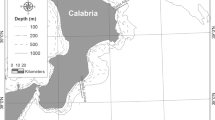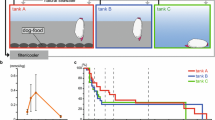Abstract
The article describes the parameters of maintaining the gutless symbiotrophic annelid Siboglinum fiordicum in laboratory conditions outside the marine environment for 64 days.
Similar content being viewed by others
Avoid common mistakes on your manuscript.
Siboglinidae Caullery, 1914 is a family of marine annelids, which are all devoid of a digestive tract. Their nutrition is derived from symbiotic bacteria, which inhabit a special organ known as the trophosome. Frenulate pogonophorans (the subfamily Siboglininae Caullery, 1914) are the largest group of the family and are widespread in all oceans of the globe. Frenulate pogonophorans are slender worms and live in chitin tubes embedded in soft deposits. Symbionts of certain frenulate pogonophorans are capable of oxidizing hydrogen sulfide or methane [1–5]. Frenulate pogonophorans are of great interest as potential indicators of undersea accumulations of hydrocarbons [6–8]. It is therefore of importance to study the ecological physiology of frenulate pogonophorans and, in particular, to determine the concentrations of gases (primarily, hydrogen sulfide and oxygen) dissolved in capillary water and essential for maintaining pogonophorans alive. The possibility of culturing frenulate pogonophorans outside of their marine habitats for a long period of time has not been described in the literature so far. In this work, we attempted to culture frenulate pogonophorans in a specially designed marine aquarium in laboratory conditions and to determine the culture parameters.
Siboglinum fiordicum Webb, 1963 worms and mud samples were collected with a Van Veen grab sampler (0.25 m2) from a depth of 33–35 m near the Øpsesundet Strait (60°33′38″ N, 5°0′20″ E) in the North Sea from February 7 to February 15, 2022. Alive pogonophorans were placed in 50-mL tubes and transported in 2-L insulated flasks (Thermos, United States) with cooling agents. The worms were delivered to Moscow February 18, 2022 and placed in a specially designed aquarium at the Invertebrate Zoology Department (Moscow State University) February 22, 2022.
Bottom water samples to be tested for dissolved oxygen concentration and pH were collected with a Ruttner water sampler (KC Denmark A/S) in the the Øpsesundet Strait. Oxygen was measured by the Winkler method [9]; the temperature and salinity were measured with a SD204 CTD profiler (SAIV A/S, Norway). Hydrogen sulfide in interstitial sediment water (collected at 4 and 7 cm over the bottom surface) was measured by photometry with Methylene Blue [10]. Similar measurements of dissolved hydrogen sulfide in interstitial sediment water were performed with samples collected in the aquarium at 2–7 cm over the bottom after culturing worms for 2 months.
Our experimental device was based on a 140-L aquarium (80 × 50 × 35 cm). Water was prepared using a Geizer-prestizh 2 reverse osmosis system (Russia) with a ULP1812/2012 membrane (Vontron, China) and a Spectrum SRDI Ion Exchange Resins (United Kingdom). Marine water with a salinity of 33‰ was prepared using Coral Pro salt (Red Sea, Israel). Fine-pore filter foam sheets were placed in two sections of the aquarium to ensure mechanical filtration and precipitation of stirred sediment. A constant temperature of 6–8°C was maintained using a Mini 600 aquarium chiller (Resun, China). The conditions were continuously monitored and the oxygen concentration and pH were regulated using a WTW DIQ/S 282 two-channel industrial controller (Xylem, United States) with a SensoLyt® SEA pH electrode (Xylem, United States) and a FDO®700 IQ SW optical sensor for dissolved oxygen (Xylem, United States). A controller of a G7J electromagnetic valve (Camozzi, Italy) turned on a carbon dioxide inflow when pH exceeded 7.6. A general scheme of the device is shown in Fig. 1. The aquarium was set 3 months before placing pogonophorans to allow its composition to stabilize.
In total, 44 S. fiordicum worms were transferred into the aquarium. The worms were placed in plastic tubes with an inner diameter of 7 or 8 mm and a length of 10–15 cm. The lower end of a tube was closed with 100-µm bolting cloth, and holes of 2 mm in diameter were drilled in the walls at intervals of 1.5–2 cm. The holes ensured that water and sediment particles enter the tube. Plastic tubes with worms were placed in glass tanks (0.5–2 L), which were partly filled with sediment (Table 1, Fig. 1).
Sediment to place the worms in the aquarium was collected together with worms in the Øpsesundet Strait and transported in 0.5- and 2-L plastic containers. The S. fiordicum worms were kept in the aquarium for 64 days, from February 22, 2022 (placement) to April 26, 2022 (checkup). To evaluate the worm condition, worms were extracted from their plastic tubes April 26, 2022 and examined under a stereoscopic microscope. The worm condition was evaluated by worm mobility within the chitin tube, the integrity of the anterior and posterior ends, the presence of the anterior tentacle, and the natural reddish body color. Table 2 summarizes the parameters of S. fiordicum culture in laboratory conditions, which were as close as possible to the environmental conditions at the site of worm collection.
Three worms were found to be in good condition after being kept in the aquarium for 64 days. The results showed that frenulate pogonophores are possible to keep in laboratory conditions similar to those of their natural habitat for more than 2 months. A low survival of worms in laboratory conditions was possibly associated with a traumatic mode of worm sampling. Siboglinum fiordicum live in relatively long (up to 243 mm) and very thin (0.2–0.3 mm in diameter) tubes. The tubes were bent when sediment was collected with a grab sampler and during extraction of worms from sediment. Damage to soft tissues of worms was caused by tube bending and might remain undetected upon visual examination. More delicate procedures of worm collection and transportation should be developed to successfully culture S. fiordicum.
REFERENCES
Schmaljohann, R. and Flügel, H.J., Methane-oxidizing bacteria in Pogonophora, Sarsia, 1987, vol. 72, no. 1, pp. 91–98.
Schmaljohann, R., Faber, E., Whiticar, M., et al., Co-existence of methane-and sulphur-based endosymbioses between bacteria and invertebrates at a site in the Skagerrak, Mar. Ecol. Prog. Ser., 1990, vol. 61, nos. 1–2, pp. 119–124.
Naganuma, T., Elsaied, H.E., Hoshii, D., et al., Bacterial endosymbioses of gutless tube-dwelling worms in nonhydrothermal vent habitats, Mar. Biotechnol., 2005, vol. 7, no. 5, pp. 416–428.
Aida, M., Kanemori, M., Kubota, N., et al., Distribution and population of free-living cells related to endosymbiont a harbored in Oligobrachia mashikoi (a Siboglinid Polychaete) inhabiting Tsukumo Bay, Microbes Environ., 2008, vol. 23, no. 1, pp. 81–88.
Lösekann, T., Robador, A., Niemann, H., et al., Endosymbioses between bacteria and deep-sea siboglinid tubeworms from an Arctic Cold Seep (Haakon Mosby Mud Volcano, Barents Sea), Environ. Microbiol., 2008, vol. 10, no. 12, pp. 3237–3254.
Savvichev, A.S., Kadnikov, V.V., Kravchishina, M.D., et al., Methane as an organic matter source and the trophic basis of a laptev sea cold seep microbial community, Geomicrobiol. J., 2018, vol. 35, no. 5, pp. 411–423.
Rimskaya-Korsakova, N.N., Karaseva, N.P., Kokarev, V.N., et al., First Discovery of Pogonophora (Annelida, Siboglinidae) in the Kara Sea Coincide with the Area of High Methane Concentration, Dokl. Biol. Sci., 2020, vol. 490, no. 1, pp. 25–27.
Karaseva, N., Gantsevich, M., Obzhirov, A., Shakirov, R., Starovoitov, A., Smirnov, R., et al., Correlation of the siboglinid (Annelida: Siboglinidae) distribution to higher concentrations of hydrocarbons in the Sea of Okhotsk, Mar. Pollut. Bull., 2020, vol. 158, art. ID 111448.
Sovremennye metody gidrokhimicheskikh issledovanii okeana (Modern Methods of Hydrochemical Ocean Studies), Moscow: Inst. Okeanol. Akad. Nauk SSSR, 1992.
Cline, J.D., Spectrophotometric determination of hydrogen sulfide in natural waters, Limnol. Oceanogr., 1969, vol. 14, pp. 454–458.
Funding
This work was supported by the Russian Science Foundation (project no. 20-74-10011) and a state contract with Moscow State University (project no. 121032300121-0). Chemical studies were supported by a state contract with the Shirshov Institute of Oceanology (project no. 0128-2021-0004).
Author information
Authors and Affiliations
Corresponding author
Ethics declarations
Conflict of interests. The authors declare that they have no conflict of interest.
Statement on the welfare of animals. All applicable international, national, and/or institutional guidelines for the care and use of animals were followed.
Additional information
Translated by T. Tkacheva
Rights and permissions
Open Access. This article is licensed under a Creative Commons Attribution 4.0 International License, which permits use, sharing, adaptation, distribution and reproduction in any medium or format, as long as you give appropriate credit to the original author(s) and the source, provide a link to the Creative Commons license, and indicate if changes were made. The images or other third party material in this article are included in the article’s Creative Commons license, unless indicated otherwise in a credit line to the material. If material is not included in the article’s Creative Commons license and your intended use is not permitted by statutory regulation or exceeds the permitted use, you will need to obtain permission directly from the copyright holder. To view a copy of this license, visit http://creativecommons.org/licenses/by/4.0/.
About this article
Cite this article
Prudkovsky, A.A., Karaseva, N.P., Rimskaya-Korsakova, M.N. et al. First Experience of Keeping Pogonophorans (Annelida: Siboglinidae) in Laboratory Conditions. Dokl Biol Sci 506, 150–153 (2022). https://doi.org/10.1134/S001249662205009X
Received:
Revised:
Accepted:
Published:
Issue Date:
DOI: https://doi.org/10.1134/S001249662205009X





